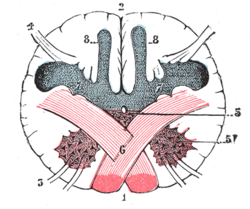Gracile nucleus
It has been suggested that this article be merged into Dorsal column nuclei. (Discuss) Proposed since May 2018. |
| Gracile nucleus | |
|---|---|
 Section of the medulla oblongata at the level of the decussation of the pyramids. Gracile nucleus is #8. | |
 Dissection of brain-stem. Dorsal view. ("nucleus gracilis" is labeled on left, second from the bottom.) | |
| Details | |
| Identifiers | |
| Latin | nucleus gracilis |
| NeuroNames | 766 |
| NeuroLex ID | birnlex_2643 |
| TA98 | A14.1.04.202 |
| TA2 | 5998 |
| FMA | 72602 |
| Anatomical terms of neuroanatomy | |
Located in the medulla oblongata, the gracile nucleus is one of the dorsal column nuclei that participate in the sensation of fine touch and proprioception of the lower body (legs and trunk). It contains second-order neurons of the posterior column-medial lemniscus pathway, which receive inputs from sensory neurons of the dorsal root ganglia and send axons that synapse in the thalamus.
The neurons contained within the nucleus form a visible bump called the gracile tubercle on the posterior side of the closed medulla at the floor of the fourth ventricle.
The gracile nucleus and fasciculus carry epicritic, kinesthetic, and conscious proprioceptive information from the lower part of the body (below the level of T6 in the spinal cord). The counterpart to the gracile nucleus and fasciculus is the cuneate nucleus and fasciculus, which carries the same type of information, but from the upper body (above T6, excepting the face and ear - the information from the face and ear is carried by the principal sensory nucleus of trigeminal nerve).
Additional images
-
Decussation of pyramids.
-
Scheme showing the course of the fibers of the lemniscus; medial lemniscus in blue, lateral in red.
-
Transverse section passing through the sensory decussation.
-
Deep dissection of cortex and brain-stem.
-
The sensory tract.
-
Fourth ventricle. Posterioe view.Deep dissection.
External links
- Stained brain slice images which include the "gracile%20nucleus" at the BrainMaps project
- NIF Search - Gracile Nucleus via the Neuroscience Information Framework






